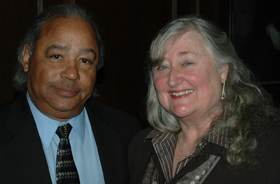Faces from the Past
 The newly recreated faces of two long departed American Indians, who once lived in the Chickahomy River valley, were recently unveiled at a reception in the Great Hall of the Wren Building. The reception celebrated nearly two decades of cooperation between the Department and Virginia's Chickahominy Tribe. The faces were reconstructed based on skulls recovered archaeologically during work performed by the Department in the late 1960's and early 1970's.
The newly recreated faces of two long departed American Indians, who once lived in the Chickahomy River valley, were recently unveiled at a reception in the Great Hall of the Wren Building. The reception celebrated nearly two decades of cooperation between the Department and Virginia's Chickahominy Tribe. The faces were reconstructed based on skulls recovered archaeologically during work performed by the Department in the late 1960's and early 1970's. Since that time, the status quo of American Indian archaeology has been up-ended by legislation returning control of American Indian bodily remains, as well as grave goods and other objects of "overwhelming cultural significance" to the tribes themselves under the terms of the Native American Graves Protection and Repatriation Act (NAGPRA). Museums and universities across the country have consulted with local Indian groups to determine how to proceed in the evaluation, curation and analysis of collected material. At William and Mary, the Department turned to the Virginia Indian community, greatly facilitated by the arrival in the Department of Danielle Moretti-Langholtz in 1995.

Because the Department's main Indian collection (and all of it's recovered native American grave materials) were from this early survey of the Chickahominy River valley, the Department approached the Chickahomony Tribe in particular to work together to fulfill the requirements of NAGPRA. From the beginning, this cooperation has been marked by respect and open-mindedness on both sides. William and Mary anthropologists have used this relationship to learn about Chickahominy traditions and oral history, while the Chickahominy have been able to see deeper into their past using the tools of archaeology and cultural studies. Both sides agree that the relationship has been productive, open and effective, largely avoiding the tensions and misunderstandings which have marked implementation of NAGPRA in some areas.
 The ceremony was attended by Arts and Sciences Dean Gene Tracy, members of the Anthropology Department, the Chickahominy Tribal Council and a representative of the Virginia Department of Historic Resources, and was moderated by Dr. Moretti-Langholtz. Speakers included Martin Gallivan, a pre-historic archaeologist who has worked closely on this project with the Chickahominy, Kathleen Bragdon, Chair of the Department, Michael Blakey, Director of the Institute for Historical Biology in the Department and Curator of the remains, and Chief Stephen Atkins of the Chickahominy Tribal Council.
The ceremony was attended by Arts and Sciences Dean Gene Tracy, members of the Anthropology Department, the Chickahominy Tribal Council and a representative of the Virginia Department of Historic Resources, and was moderated by Dr. Moretti-Langholtz. Speakers included Martin Gallivan, a pre-historic archaeologist who has worked closely on this project with the Chickahominy, Kathleen Bragdon, Chair of the Department, Michael Blakey, Director of the Institute for Historical Biology in the Department and Curator of the remains, and Chief Stephen Atkins of the Chickahominy Tribal Council.
 Skip to main content
Skip to main content
